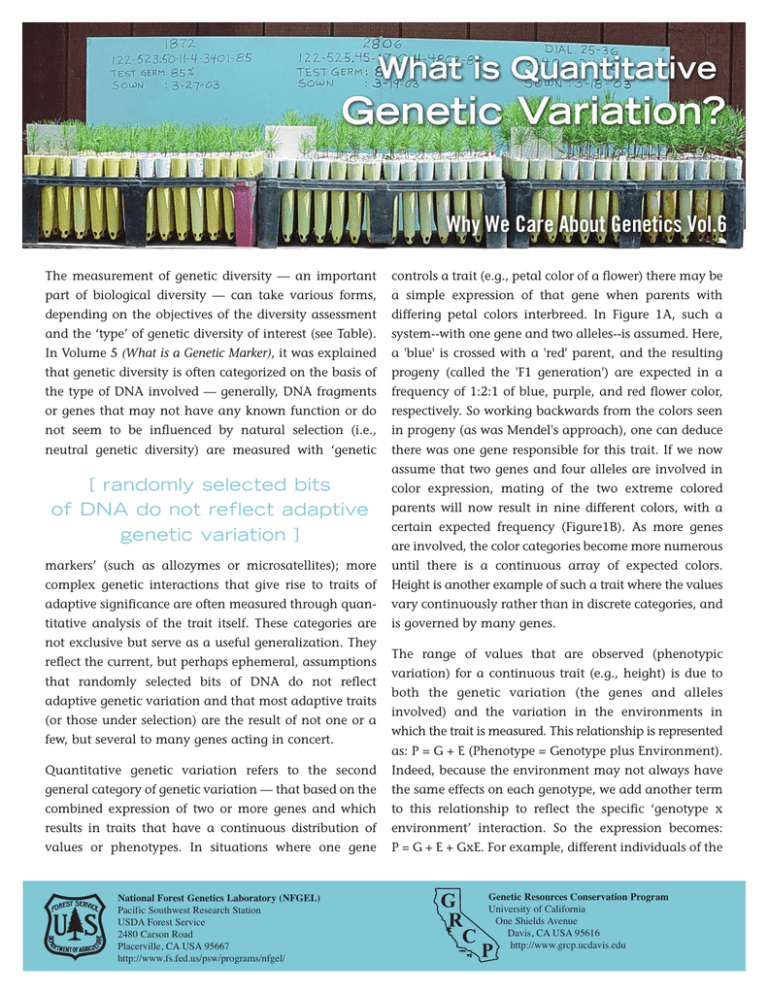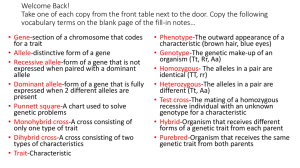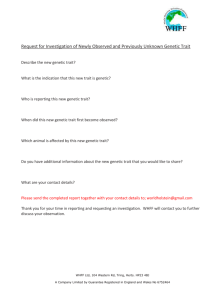The measurement of genetic diversity — an important
advertisement

The measurement of genetic diversity — an important controls a trait (e.g., petal color of a flower) there may be part of biological diversity — can take various forms, a simple expression of that gene when parents with depending on the objectives of the diversity assessment differing petal colors interbreed. In Figure 1A, such a and the ‘type’ of genetic diversity of interest (see Table). system--with one gene and two alleles--is assumed. Here, In Volume 5 (What is a Genetic Marker), it was explained a 'blue' is crossed with a 'red' parent, and the resulting that genetic diversity is often categorized on the basis of progeny (called the 'F1 generation') are expected in a the type of DNA involved — generally, DNA fragments frequency of 1:2:1 of blue, purple, and red flower color, or genes that may not have any known function or do respectively. So working backwards from the colors seen not seem to be influenced by natural selection (i.e., in progeny (as was Mendel's approach), one can deduce neutral genetic diversity) are measured with ‘genetic there was one gene responsible for this trait. If we now assume that two genes and four alleles are involved in [ randomly selected bits of DNA do not reflect adaptive genetic variation ] color expression, mating of the two extreme colored markers’ (such as allozymes or microsatellites); more until there is a continuous array of expected colors. complex genetic interactions that give rise to traits of Height is another example of such a trait where the values adaptive significance are often measured through quan- vary continuously rather than in discrete categories, and titative analysis of the trait itself. These categories are is governed by many genes. not exclusive but serve as a useful generalization. They reflect the current, but perhaps ephemeral, assumptions that randomly selected bits of DNA do not reflect adaptive genetic variation and that most adaptive traits (or those under selection) are the result of not one or a few, but several to many genes acting in concert. parents will now result in nine different colors, with a certain expected frequency (Figure1B). As more genes are involved, the color categories become more numerous The range of values that are observed (phenotypic variation) for a continuous trait (e.g., height) is due to both the genetic variation (the genes and alleles involved) and the variation in the environments in which the trait is measured. This relationship is represented as: P = G + E (Phenotype = Genotype plus Environment). Quantitative genetic variation refers to the second Indeed, because the environment may not always have general category of genetic variation — that based on the the same effects on each genotype, we add another term combined expression of two or more genes and which to this relationship to reflect the specific ‘genotype x results in traits that have a continuous distribution of environment’ interaction. So the expression becomes: values or phenotypes. In situations where one gene P = G + E + GxE. For example, different individuals of the National Forest Genetics Laboratory (NFGEL) Pacific Southwest Research Station USDA Forest Service 2480 Carson Road Placerville, CA USA 95667 http://www.fs.fed.us/psw/programs/nfgel/ Genetic Resources Conservation Program University of California One Shields Avenue Davis, CA USA 95616 http://www.grcp.ucdavis.edu ATTRIBUTE SINGLE LOCUS MULTIPLE LOCI ALLOZYMES DNA QUANTITATIVE Sample size needed Small Small Large Material needed Various Various Measurements Time Months Months-years Years (typically, several growing seasons or generations) Data type Protein variation DNA sequence or fragment variation Continuous phenotypic trait variation Probability of detecting variation Low High Higher Ability to detect genetic structure Yes Yes Yes (design dependent) Ability to study adaptation Often not Often not Typically yes GENETICS same species may react differently microenvironment (i.e., removes bias). when moved from a cooler to a warmer Measurements are then taken on all test environment: some may grow more plants, often over more than one season quickly, some more slowly, and some or year, and appropriate statistical may not be affected. methods are used to analyze the data (e.g., ANOVA — analysis of variance). [ the great divide between single- and multi-locus methods for studying genetic diversity is narrowing ] Results from such tests provide information on whether or not there are genetic differences between the test plants for the traits measured and the relative amount of genetic vs. environmental effects on the traits. Photo Credits: USDA Forest Service, Region 5 Genetic Resource Program genome location of major genes affecting a quantitative trait. A second more recent approach is that of genetic association mapping: finding statistical associations between molecular markers and particular phenotypes that demonstrate expression of the trait of interest. Quantitative analysis of these continu- using marker technology to assist in populations rather than test popula- ous traits has traditionally involved the studying quantitative tions constructed by controlled breeding use of carefully designed studies (usually traits. One approach is to identify and generally identifies closer connec- field tests) that allow one to tease apart ‘quantitative trait loci’ (QTLs) — genetic tions (i.e., finer mapping) between genetic and environmental factors. loci or chromosomal regions that are phenotypes and molecular markers Replication of the test plants evens out statistically related to the genetic portion than standard QTL approaches. More environmental variation; planting test of the quantitative trait as measured in recently, tools of genetic association plants on sites that are as uniform as progeny that result from specific crosses. mapping have been integrated with possible reduces environmental varia- Several of these QTL mapping studies those of population genomics to produce tion; using clonal replicates of the have been developed for growth and a powerful approach for studying the plants provides a direct measure of drought tolerance in loblolly pine genetic basis of adaptive variation in within-site environmental variation; (Pinus taeda). Although sometimes plant species. The great divide between and randomization of the plants disas- inefficient, this approach can produce single- and multi-locus methods for sociates each plant from any particular information on the number and studying genetic diversity is narrowing. Number of Plants This approach can be used on natural Number of Plants Recently there has been progress towards A. B. traditionally Figure 1. Hypothetical example of progeny (resulting from a cross between two extremes for the trait) expected when there is: A) a single locus controlling petal color; and B) two loci controlling petal color The United States Department of Agriculture (USDA) prohibits discrimination in all its programs and activities on the basis of race, color, national origin, gender, religion, age, disability, political beliefs, sexual orientation and marital or family status. (Not all prohibited bases apply to all programs.) Persons with disabilities who require alternative means for communication of program information (Braille, large print, audiotape, etc.) should contact USDA’s TARGET Center at: (202) 720-2600 (voice and TDD). To file a complaint of discrimination, write: USDA Director, Office of Civil Rights, Room 326-W, Whitten Building, 14th and Independent Avenue, SW, Washington, DC 20250-9410, or call: (202) 720-5964 (voice or TDD). USDA is an equal opportunity provider and employer. 2006









